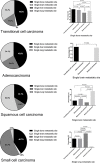The prognostic value of histological subtype in patients with metastatic bladder cancer
- PMID: 28415699
- PMCID: PMC5438659
- DOI: 10.18632/oncotarget.16083
The prognostic value of histological subtype in patients with metastatic bladder cancer
Abstract
We aim to evaluate the prognostic effect of the histological sub-type in patients with metastatic bladder cancer based on the Surveillance Epidemiology and End Results database. A total of 2634 eligible patients were included. The histological subtypes were: transitional cell carcinoma (TCC; 75.2%); adenocarcinoma (3.3%); squamous cell carcinoma (SQCC; 4.1%); and small cell carcinoma (4.3%). A significant association of adenocarcinoma with better survival outcomes (P < 0.015), and that of SQCC with worse outcomes (P < 0.001) was observed. On multivariate analysis, adenocarcinoma was significantly associated with longer and SQCC with shorter survival time as compared to TCC. Overall, 1331 (50.5%) patients had a single metastatic site and 523 (19.9%) had multiple sites involved. Single-site metastasis had a better survival outcome than multiple metastases (P < 0.001). Histological sub-type and presence of multiple metastatic sites are independent predictors of survival time. Prospective, in-depth research is needed to determine optimal therapeutic strategies for different histological subtypes of bladder cancer with different metastatic patterns.
Keywords: distant metastasis; histology; prognosis; survival; urinary bladder neoplasms.
Conflict of interest statement
None declared.
Figures



Similar articles
-
The prognostic effect of metastasis patterns on overall survival in patients with distant metastatic bladder cancer: a SEER population-based analysis.World J Urol. 2021 Nov;39(11):4151-4158. doi: 10.1007/s00345-021-03721-6. Epub 2021 May 24. World J Urol. 2021. PMID: 34028594
-
The role of surgery on the primary tumor site in bladder cancer with distant metastasis: significance of histology type and metastatic pattern.Cancer Med. 2020 Dec;9(24):9293-9302. doi: 10.1002/cam4.3560. Epub 2020 Oct 27. Cancer Med. 2020. PMID: 33107706 Free PMC article.
-
Transitional cell carcinoma of the urinary bladder with regional lymph node involvement treated by cystectomy: clinicopathologic features associated with outcome.Cancer. 2003 May 15;97(10):2425-31. doi: 10.1002/cncr.11370. Cancer. 2003. PMID: 12733141
-
Clinical analysis of small cell carcinoma of the bladder in Chinese: nine case reports and literature reviews.World J Surg Oncol. 2017 Jan 26;15(1):33. doi: 10.1186/s12957-016-1079-y. World J Surg Oncol. 2017. PMID: 28125986 Free PMC article. Review.
-
[Prognostic factors of survival in infiltrating urothelial bladder carcinoma. A retrospective study of 158 patients treated by radical cystectomy].Bull Cancer. 1996 Feb;83(2):139-46. Bull Cancer. 1996. PMID: 8652908 Review. French.
Cited by
-
Does Health Insurance Modify the Association Between Race and Cancer-Specific Survival in Patients with Urinary Bladder Malignancy in the U.S.?Int J Environ Res Public Health. 2019 Sep 13;16(18):3393. doi: 10.3390/ijerph16183393. Int J Environ Res Public Health. 2019. PMID: 31540198 Free PMC article.
-
Autophagy modulation in bladder cancer development and treatment (Review).Oncol Rep. 2019 Nov;42(5):1647-1655. doi: 10.3892/or.2019.7286. Epub 2019 Aug 21. Oncol Rep. 2019. PMID: 31436298 Free PMC article. Review.
-
Effects of Different Organ Metastases on the Prognosis of Stage IV Urothelial Carcinoma of the Bladder.J Oncol. 2022 Nov 2;2022:8594022. doi: 10.1155/2022/8594022. eCollection 2022. J Oncol. 2022. PMID: 36385960 Free PMC article.
-
Prognostic nomogram for bladder cancer with brain metastases: a National Cancer Database analysis.J Transl Med. 2019 Dec 9;17(1):411. doi: 10.1186/s12967-019-2109-7. J Transl Med. 2019. PMID: 31815624 Free PMC article.
-
Gender dimorphism in survival of patients with lymph node metastasis of bladder cancer.Ther Adv Med Oncol. 2022 Jun 28;14:17588359221108690. doi: 10.1177/17588359221108690. eCollection 2022. Ther Adv Med Oncol. 2022. PMID: 35782750 Free PMC article.
References
-
- Siegel RL, Miller KD, Jemal A. Cancer statistics, 2016. CA Cancer J Clin. 2016;66:7–30. - PubMed
-
- Parkin DM. The global burden of urinary bladder cancer. Scand J Urol Nephrol. 2008. pp. 12–20. - PubMed
-
- Lopez-Beltran A. Bladder cancer: clinical and pathological profile. Scand J Urol Nephrol. 2008. pp. 95–109. - PubMed
-
- Pasquier D, Barney B, Sundar S, Poortmans P, Villa S, Nasrallah H, Boujelbene N, Ghadjar P, Lassen-Ramshad Y, Senkus E, Oar A, Roelandts M, Amichetti M, et al. Small Cell Carcinoma of the Urinary Bladder: A Retrospective, Multicenter Rare Cancer Network Study of 107 Patients. Int J Radiat Oncol Biol Phys. 2015;92:904–10. - PubMed
-
- Koay EJ, Teh BS, Paulino AC, Butler EB. A Surveillance, Epidemiology, and End Results analysis of small cell carcinoma of the bladder: epidemiology, prognostic variables, and treatment trends. Cancer. 2011;117:5325–33. - PubMed
MeSH terms
LinkOut - more resources
Full Text Sources
Other Literature Sources
Medical

